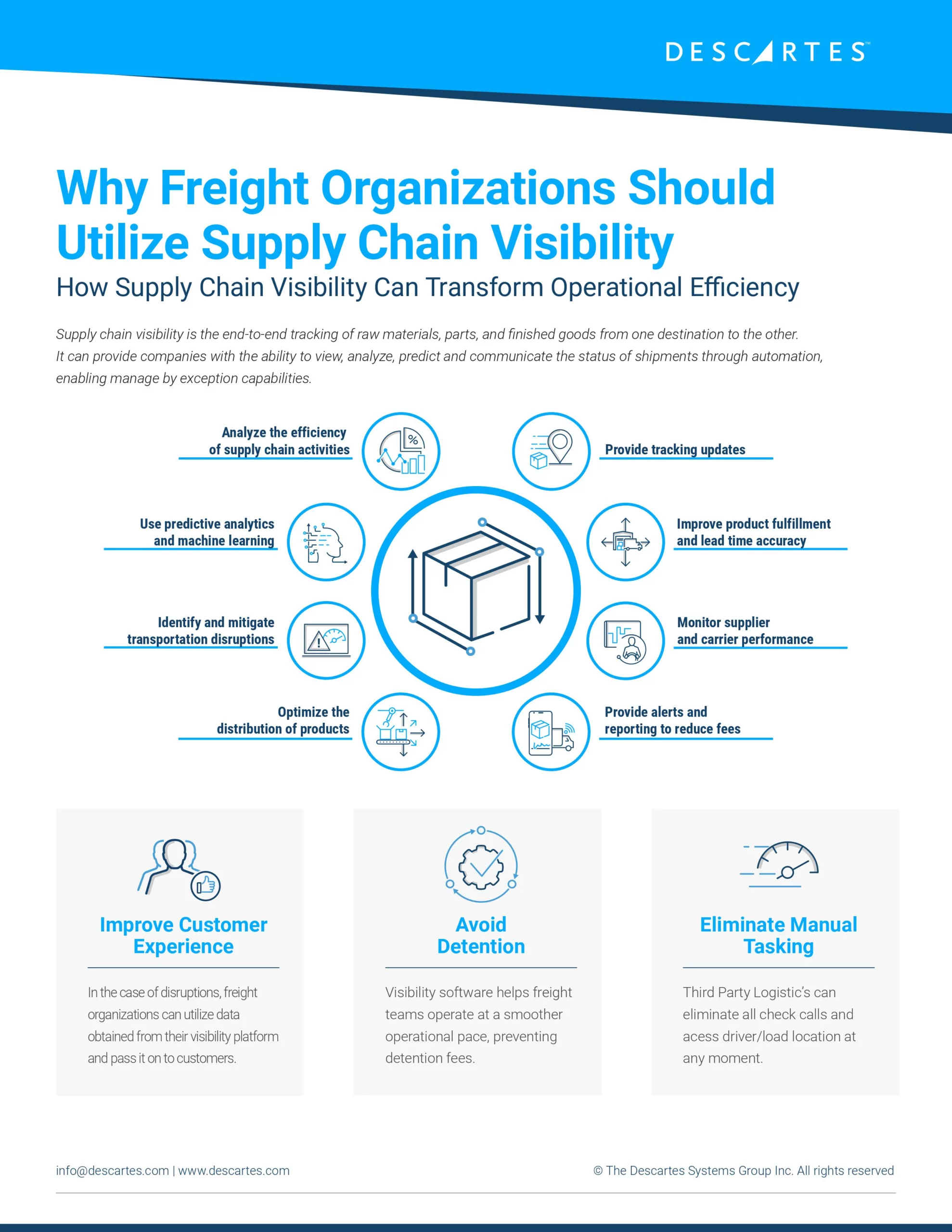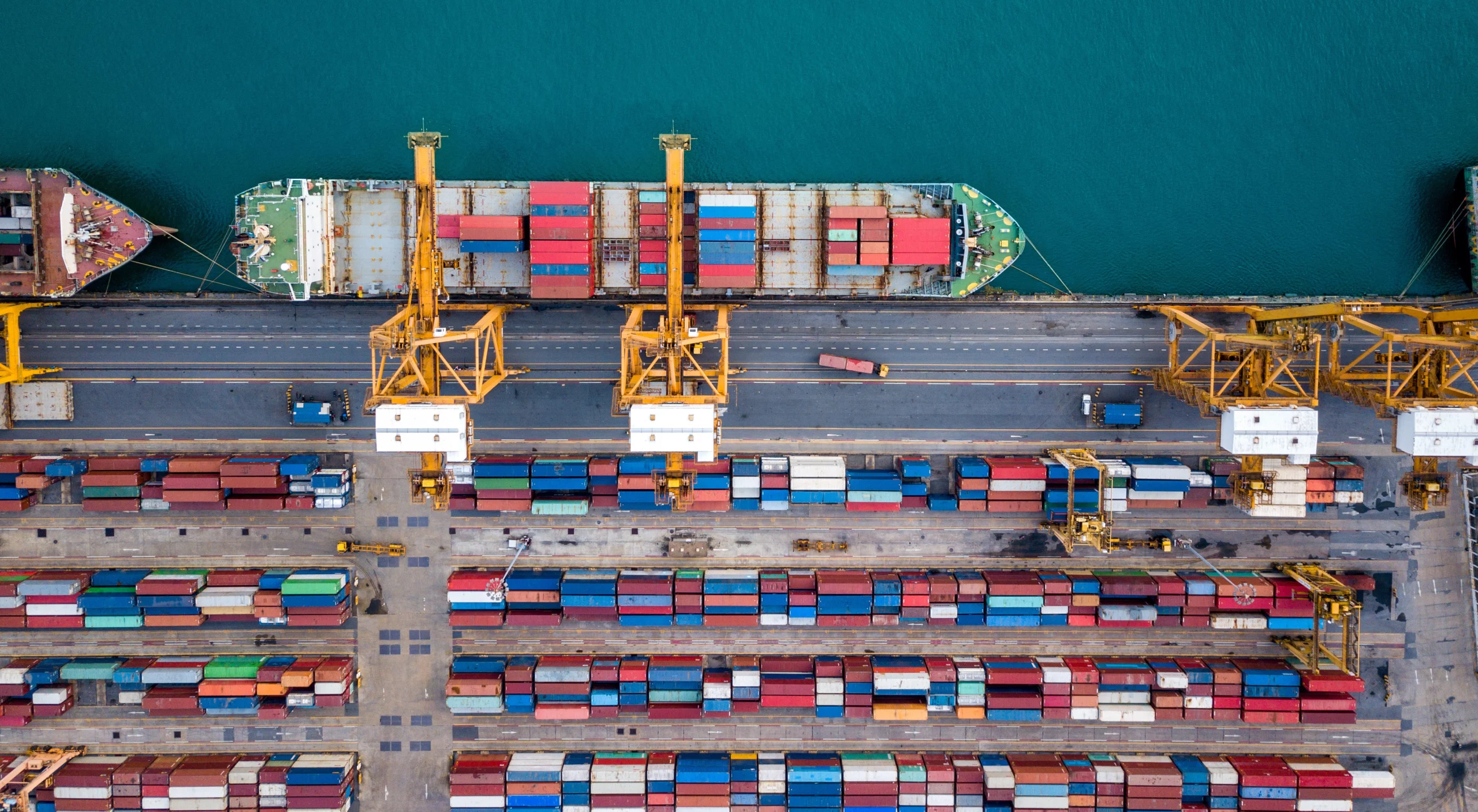Key Takeaways
- Supply Chain Visibility Defined: Supply chain visibility involves end-to-end tracking of raw materials, goods, and products, providing real-time data for better management, predictive capabilities, and operational efficiency across various stakeholders including shippers, freight brokers, carriers, and 3PL’s.
- Benefits and Features: Visibility platforms offer real-time data such as load locations, predictive ETAs, and geo-based notifications. Benefits include better customer experience, avoiding detention fees, eliminating manual tasking, improving ROI, and more effective inventory management.
- Mitigating Risk with Visibility: Lack of visibility in the supply chain can result in challenges like route disruptions, late shipments, and financial penalties. Advanced supply chain solutions use AI and predictive analytics for better decision-making and operational efficiency.
What Is Supply Chain Visibility?
Supply chain visibility is the end-to-end tracking of raw materials, parts, and finished goods from one destination to the other. It can provide companies with the ability to view, analyze, predict and communicate the status of shipments through automation, enabling manage by exception capabilities.
Shippers, manufacturers, and distributors utilize supply chain visibility to improve performance and get actionable insights regarding their shipments. Doing so helps organizations gain better control over their inventory and improve operational efficiency.
In the freight industry supply chain visibility can be used by:
- Shippers
- Freight Brokers & 3PL’s
- Carriers
Visibility platforms are unique in the sense of the data they provide to users, which is extremely valuable and beneficial compared to other forms of freight software. Users have access to:
- Predictive ETA’s
- Instant Updates & Alerts
- Real-Time Load Location
- Carrier Performance Data
- Geo-based Delivery Notifications
Users on a visibility platform can utilize these data points in multiple ways to ultimately help make better informed decisions and share data securely with relevant stakeholders. This is essential to improve logistics workflows, save time on manual tasks, increase profits, and reduce production waste.

Main Features & Capabilities
Visibility in the supply chain is critical because it gives each player a view of critical touchpoints in the journey of your products. This enables each business across the supply chain to monitor, anticipate and diagnose problems, as well as explore ways to troubleshoot and improve efficiency.
The main features of a visibility platform include, but are not limited to:
- Provide tracking updates throughout the different stages of a shipments journey such as shipping, in-transit, or delivery
- Improve product fulfillment and lead time accuracy
- Monitor supplier and carrier performance
- Provide alerts and reporting to reduce detention and demurrage fees
- Optimize the distribution of products by understanding in-transit inventory
- Identify and mitigate transportation disruptions and disputes
- Use predictive analytics and machine learning to support the optimization of a transportation model
- Analyze the efficiency of supply chain activities

Benefits of Supply Chain Visibility Software
Supply chain visibility benefits multiple parties within the supply chain, not just the organization utilizing the platform.
Any disruption in your supply chain, from upstream procurement of raw materials or products to final delivery, can create inefficiencies and down time that damage customer relationships and negatively impact your bottom line. Visibility allows you to access and share real-time data across supply chain operations, leading to greater efficiency, enhanced customer satisfaction, risk reduction and better profit margins.
Improve Customer Experience – Communication and transparency are key to building trust with other parties within your supply chain, especially customers. In the case of disruptions, freight organizations can utilize the data obtained from their visibility platform and pass it on to their customers. This is a well-known way to help build and improve on customer relationships within the industry and boost the value for all working parties.
Avoid Detention – Carriers allot their trucks to pick up and deliver a shipment during a preset amount of time. Going over this time means carriers can charge shippers and brokers the extra time in the form of a detention fee. Detention fees are expensive and cost the freight industry billions of dollars each year. Utilizing supply chain visibility software helps freight teams operate at a smoother operational pace and prevent detention fees using real-time data and insights.
Eliminate Manual Tasking – Automatic shipment updates alert staff of at risk shipments based on predictive ETAs; eliminating the time employees must spend in order to manually source the information. The old-fashioned way of tracking shipment status was by calling the driver on their mobile phone and asking for location. These are known as check calls. With load tracking platforms, brokers can eliminate all check calls and access driver location at any moment. This also improves driver safety (eliminating the need to talk on the phone while driving).
Increase ROI – Using the power of a visibility platform and the high value data it provides, freight teams can make better decisions that cut away costs, improve productivity, save time, and increase profit margins.
On Time Shipments – Shippers are expected to deliver on time. But even in the case of a delayed shipment, teams can react accordingly using a visibility platform. Teams can reroute the shipment, update customers, and change delivery windows in order to increase the chances of an on-time delivery.
Improved Inventory Management – Manually checking inventory is a slow process. Visibility platforms allow for freight organizations and their customers to stay up to date on inventory levels throughout the process of pickup and delivery. This helps reduce the amount of time it takes to verify shipment information.
Real-time Clearance Information – Schedule the pickup of cargo/shipment without the delays. With a visibility platform, there is no need for shippers to wait for their customs broker to advise cargo through customs clearance. Shippers can now directly access, monitor and alert their teams of real-time customs clearance data through their visibility platform and into their TMS.
How Much Can I Expect to Pay for Supply Chain Software?
Each visibility platform will offer different rulesets for pricing. However, you can expect most to pay on a per load basis.
Take for example the Descartes MacroPoint’s Real-Time Visibility Platform, which starts pricing at $5 per load and can be discounted significantly through volume-based price breaks. The more loads you need tracked within a given year, the cheaper the pricing.
For more information regarding Descartes MacroPoint pricing, speak to one of our experts or check out our in-depth article here.
What Supply Chain Visibility Platform Is Easiest to Use?
Not all visibility platforms are created equal. As of May 1st, 2023 here are the top providers on the market (according to G2 software reviews).
1. Descartes MacroPoint
4.7/5 star rating
143 total reviews
2. Shippeo
4.6/5 star rating
89 total reviews
3. Project 44
4.6/5 star rating
353 total reviews
4. Fourkites
4.5/5 star rating
246 total reviews
5. SAP Integrated Business Planning
4.3/5 rating
225 total reviews
6. Fleetx
4.7/5 star rating
51 total reviews
7. Go Comet
4.6/5 star rating
55 total reviews
8. Overhaul
4.6/5 star rating
43 total review
9. Anvyl
4.6/5 star rating
42 total reviews
10. Tive
4.4/5 star rating
32 total reviews

How Supply Chain Visibility Mitigates Risk
Risk is often the biggest challenge that companies face on a daily basis.
Without true visibility, freight teams are often dealing with common problems such as route disruptions, late shipments, an inability to locate freight, and a lack of high quality data lead to:
- Penalties & Fees – According to the Federal Register, demurrage and detention fees costed carriers over $8.9 billion between 2020 and 2022
- Late Shipments – The root cause of it all, late shipments are due to a variety of issues. Not knowing why is an even bigger problem (lack of visibility)
- Poor Productivity – Without understanding basic shipment data freight teams are left with poor data and decision making, often costing the organization time and money
What Are The Most Important Elements of Supply Chain Visibility?
Key elements of supply chain visibility include accurate shipment status and location data, automated updates and alerts in real-time, and high levels of carrier tracking compliance.
Advanced supply chain visibility solutions incorporate artificial intelligence (AI) technology and predictive analytics to help identify trends, improve planning, and increase operational efficiency.
The Descartes MacroPoint Visibility Platform
Managing your supply chain is no easy task. It takes time, manpower, and resources.
But with Descartes MacroPoint, you can manage the flow of your shipments with efficiency and accuracy, at a fraction of the cost. Our supply chain visibility software allows users to view, in real-time—the status of any shipment anywhere, on any device.


